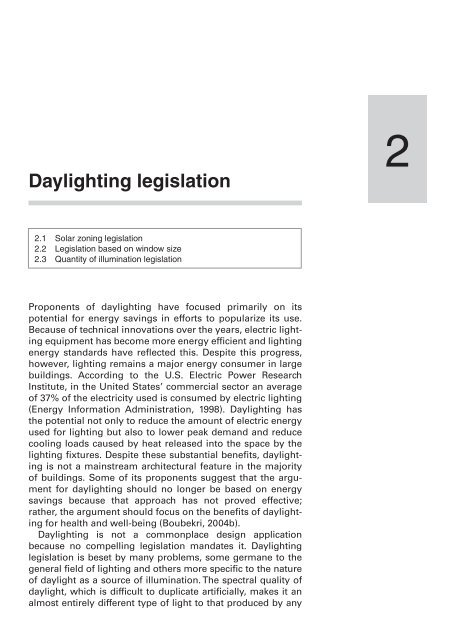Daylighting, Architecture and Health: Building Design Strategies
Daylighting, Architecture and Health: Building Design Strategies
Daylighting, Architecture and Health: Building Design Strategies
You also want an ePaper? Increase the reach of your titles
YUMPU automatically turns print PDFs into web optimized ePapers that Google loves.
<strong>Daylighting</strong> legislation<br />
2<br />
2.1 Solar zoning legislation<br />
2.2 Legislation based on window size<br />
2.3 Quantity of illumination legislation<br />
Proponents of daylighting have focused primarily on its<br />
potential for energy savings in efforts to popularize its use.<br />
Because of technical innovations over the years, electric lighting<br />
equipment has become more energy efficient <strong>and</strong> lighting<br />
energy st<strong>and</strong>ards have reflected this. Despite this progress,<br />
however, lighting remains a major energy consumer in large<br />
buildings. According to the U.S. Electric Power Research<br />
Institute, in the United States ’ commercial sector an average<br />
of 37% of the electricity used is consumed by electric lighting<br />
(Energy Information Administration, 1998). <strong>Daylighting</strong> has<br />
the potential not only to reduce the amount of electric energy<br />
used for lighting but also to lower peak dem<strong>and</strong> <strong>and</strong> reduce<br />
cooling loads caused by heat released into the space by the<br />
lighting fixtures. Despite these substantial benefits, daylighting<br />
is not a mainstream architectural feature in the majority<br />
of buildings. Some of its proponents suggest that the argument<br />
for daylighting should no longer be based on energy<br />
savings because that approach has not proved effective;<br />
rather, the argument should focus on the benefits of daylighting<br />
for health <strong>and</strong> well-being (Boubekri, 2004b).<br />
<strong>Daylighting</strong> is not a commonplace design application<br />
because no compelling legislation m<strong>and</strong>ates it. <strong>Daylighting</strong><br />
legislation is beset by many problems, some germane to the<br />
general field of lighting <strong>and</strong> others more specific to the nature<br />
of daylight as a source of illumination. The spectral quality of<br />
daylight, which is difficult to duplicate artificially, makes it an<br />
almost entirely different type of light to that produced by any











